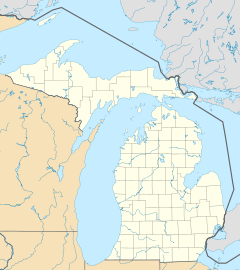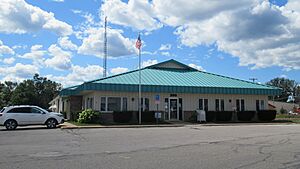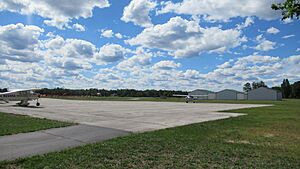Kalkaska, Michigan facts for kids
Quick facts for kids
Kalkaska, Michigan
|
|
|---|---|
|
Village
|
|
| Village of Kalkaska | |
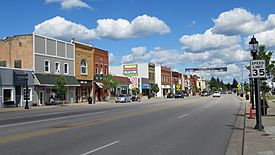
Downtown Kalkaska along Cedar Street
|
|
| Nickname(s):
Trout Capital of Michigan
|
|
| Motto(s):
"Space to Grow"
|
|
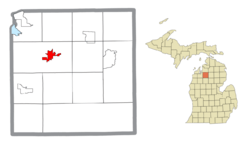
Location within Kalkaska County
|
|
| Country | |
| State | |
| County | Kalkaska |
| Township | Kalkaska |
| Platted | 1873 |
| Incorporated | 1887 |
| Founded by | Albert A. Abbott |
| Government | |
| • Type | Village council |
| Area | |
| • Total | 2.69 sq mi (6.96 km2) |
| • Land | 2.64 sq mi (6.83 km2) |
| • Water | 0.05 sq mi (0.13 km2) |
| Elevation | 1,033 ft (315 m) |
| Population
(2020)
|
|
| • Total | 2,132 |
| • Density | 808.80/sq mi (312.25/km2) |
| Demonym(s) | Kalkaskian(s) |
| Time zone | UTC−5 (Eastern (EST)) |
| • Summer (DST) | UTC−4 (EDT) |
| ZIP code(s) |
49646
|
| Area code(s) | 231 |
| FIPS code | 26-42260 |
| GNIS feature ID | 0629450 |
Kalkaska is a village in the U.S. state of Michigan. In 2020, about 2,132 people lived there. This was a bit more than the 2,020 people who lived there in 2010.
Kalkaska is close to Traverse City. Many people who live in Kalkaska travel to Traverse City for work. The village is also famous for hosting the National Trout Festival. This fun event started in 1935.
Contents
History of Kalkaska
Kalkaska was first planned out in 1873 by A. A. Abbott and R. L. Thompson. They owned a sawmill and knew that the railroad would soon arrive.
The village faced several big fires in its early days. On July 5, 1908, a fire started in the business area. It burned most of the stores. A local photographer, E. L. Beebe, took pictures of the fire. Postcards of these pictures were sold widely. Two years later, in 1910, another fire hit downtown Kalkaska. Then, in 1925, the downtown area was badly damaged by the biggest fire since 1908.
In 1916, the famous writer Ernest Hemingway visited Kalkaska. He fished in the area and later wrote about the town in his story "The Battler". There is a special marker at the Rugg Pond Dam on the Rapid River. This is where Hemingway reportedly fished one night.
In the 1970s, natural gas and oil were found nearby. This discovery helped the village grow a lot. However, this period of fast growth has slowed down since then.
In 1993, the schools in Kalkaska made national news. They had money problems and had to close for two months. After this, new funding rules helped Kalkaska and other small rural school districts in Michigan.
In 2014, Walmart planned to open a store in Kalkaska. Before this, the closest Walmart was about 25 miles (40 km) away in Traverse City. People in Kalkaska discussed if a big store like Walmart would change the village's small-town feel.
Where is Kalkaska?
Kalkaska is located in Northern Michigan. The village covers about 3.17 square miles (8.21 square kilometers). Most of this area is land, with a small part being water.
The village sits on a large flat area, like much of Northern Michigan. The Boardman River flows through Kalkaska. To the north and east, the land is mostly flat with gentle hills and lots of farmland. To the south and east, the land is steeper with many streams. To the north, there are more lakes.
Ancient glaciers shaped Kalkaska's landscape. These glaciers moved across Michigan during the Ice Age. They created small hills called drumlins, along with valleys and basins. The water in these areas today also came from the glaciers. This process is called glaciation.
Kalkaska gets a lot of snow because it is in a snowbelt. This means it receives heavy amounts of lake effect snow from Lake Michigan.
Weather in Kalkaska
Kalkaska has big differences in temperature throughout the year. Summers are warm to hot and often humid. Winters are cold, sometimes very cold. This type of weather is called a humid continental climate.
People of Kalkaska
| Historical population | |||
|---|---|---|---|
| Census | Pop. | %± | |
| 1880 | 496 | — | |
| 1890 | 1,161 | 134.1% | |
| 1900 | 1,304 | 12.3% | |
| 1910 | 1,415 | 8.5% | |
| 1920 | 866 | −38.8% | |
| 1930 | 861 | −0.6% | |
| 1940 | 1,132 | 31.5% | |
| 1950 | 1,250 | 10.4% | |
| 1960 | 1,321 | 5.7% | |
| 1970 | 1,475 | 11.7% | |
| 1980 | 1,654 | 12.1% | |
| 1990 | 1,952 | 18.0% | |
| 2000 | 2,226 | 14.0% | |
| 2010 | 2,020 | −9.3% | |
| 2020 | 2,132 | 5.5% | |
| U.S. Decennial Census | |||
How Many People Live Here?
In 2010, there were 2,020 people living in Kalkaska. These people made up 871 households and 482 families. The village had about 647 people per square mile (250 per square kilometer).
Most people in the village were White (95.6%). There were also small numbers of African American, Native American, and Asian residents. About 1.8% of the population was Hispanic or Latino.
About 29.2% of households had children under 18. Many households (44.7%) were not families. The average age in the village was 37.9 years old.
Getting Around Kalkaska
Airport
Kalkaska has its own small airport called Kalkaska City Airport. It has a paved runway.
Main Roads in Kalkaska
 US 131 runs north and south through Kalkaska. It is known as "Cedar Street" in the village. This highway goes north to Petoskey and south to the Indiana state line.
US 131 runs north and south through Kalkaska. It is known as "Cedar Street" in the village. This highway goes north to Petoskey and south to the Indiana state line. M-66 also runs north and south through Kalkaska. It shares Cedar Street with US 131 for a bit. M-66 goes north to Charlevoix and south to the Indiana state line.
M-66 also runs north and south through Kalkaska. It shares Cedar Street with US 131 for a bit. M-66 goes north to Charlevoix and south to the Indiana state line. M-72 runs east and west through Kalkaska County. In the heart of the village, it also runs north and south on Cedar Street. West of Kalkaska, M-72 goes to Empire on Lake Michigan. East of Kalkaska, it goes to Harrisville on Lake Huron.
M-72 runs east and west through Kalkaska County. In the heart of the village, it also runs north and south on Cedar Street. West of Kalkaska, M-72 goes to Empire on Lake Michigan. East of Kalkaska, it goes to Harrisville on Lake Huron.
Learning in Kalkaska
Schools in Kalkaska are managed by Kalkaska Public Schools. There is one high school in the district, Kalkaska High School.
Kalkaska is also located near several colleges. These include North Central Michigan College in Petoskey, Northwestern Michigan College in Traverse City, Kirtland College, and Baker College in Cadillac.
Fun Things to Do in Kalkaska
Many visitors come to Kalkaska to enjoy the nearby lakes and rivers. Popular spots include Torch Lake, the Jordan River, Rapid River, and Manistee River.
Kalkaska hosts two main festivals:
- The National Trout Festival happens at the end of April. It celebrates the start of trout fishing season.
- The Kalkaska County Agricultural Fair is held in the first week of August. It shows off local livestock from 4-H clubs, handmade crafts, and entertainment.
Fall is also a popular time for visitors to see the beautiful autumn leaves.
In early November, Kalkaska is the starting point for the Iceman Cometh biking challenge. This is a 27.2-mile (43.8 km) off-road bike race. It runs from the village to Traverse City along the VASA Trail. Thousands of bikers come for this famous race. Finishing the race is a big achievement for mountain biking fans.
The village has several parks, including Chalker Park and Imagination Station. Mill Pond Park is a small park with a pavilion.
The Kalkaska Area Recreation Transportation (KART) Trail is a path for walking and biking. It goes around the county's government, school, and recreation areas. There are plans to connect it to the TART Trail.
Industry in Kalkaska
Important industries in Kalkaska and the surrounding area include service, oil and gas, manufacturing, and tourism.
Kalkaska is well-known as a great place for fishing. It has many inland lakes and rivers like the Boardman, Rapid, and Manistee Rivers. The National Trout Festival has been held in Kalkaska every year since 1933. A huge statue of a brook trout stands in the town square. The author Jim Harrison wrote about this festival in his 1991 book Just Before Dark: Collected Non-fiction.
Notable people
- Emil Frisk (1874–1922), a professional baseball player. He played for teams like the Cincinnati Reds and Detroit Tigers.
- Renee Raudman, a voice and television actress.
- Ron Ryckman Sr., a member of the Kansas Senate.
- Betty Wanless (1928–1995), a player in the All-American Girls Professional Baseball League.
- Ron Winter, a former official for NCAA and NFL games.
See also
 In Spanish: Kalkaska para niños
In Spanish: Kalkaska para niños


